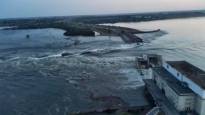In Ukraine, there is no doubt for a moment that Russia was behind blowing up the dam, writes Ylen’s Kyiv reporter Maxim Fedorov.
Maxim Fedorov
KIEV After the Russians occupied parts of the Kherson region at the beginning of the war, the importance of the Kahovka dam in terms of the course of the war increased significantly. Between Zaporizhia and Nova Kahovka, there is a 240-kilometer artificial lake with no bridges, so every bridge on the Dnieper River plays a decisive role militarily.
When the Ukrainian army was preparing to liberate the city of Kherson and its surroundings last summer and autumn, it made the dam bridge unfit for moving heavy military equipment with precision strikes. However, the dam itself was spared from destruction.
In October, the President of Ukraine Volodymyr Zelenskyi told that the Russians had mined the dam and warned of the disastrous consequences of the dam’s collapse. On the day of the liberation of Kherson, i.e. November 11, the Russians retreating from the right bank blew up the Kahovka bridge so that the Ukrainian army could not cross the river. The dam itself withstood even this blow and became part of the front line.
Although Ukraine knew how to wait for the destruction of the dam, in the end it came as a surprise to Ukrainians. They were shocked that so many civilians could be sacrificed at once for military purposes.
The social media accounts of Ukrainians were filled with the key tag #Russiaisaterroriststate, i.e. Russia is a terrorist state. The fact that in the morning the UN reminded on Twitter that Tuesday is the day of the Russian language was particularly nasty to the Ukrainians. The destruction of the Kahovka dam was noticed in the UN only a few hours later.
Who benefits from blowing up the dam?
Although it is too early to officially say who blew up the Kahovka dam, there was no doubt in Ukraine that it was done by Russian forces. Kiev accused Russia of natural destruction and technological terrorism.
It is hard to believe that Ukraine was involved in blowing up the dam, and not only because such an action is not part of Ukrainian warfare. It could have brought military benefits only in the opinion of the Russians, who are currently afraid of an attack by the Ukrainian army. The flooding of the Dnieper downstream makes it almost impossible to cross the river, and the Russians can move their forces further east, where the threat of attack is higher.
At the same time, destroying the dam was shooting yourself in the foot. First, the floodwaters will bury the Russian defensive positions on the left bank of the river. Secondly, if there is no point in taking decisive military action from Zaporizhzhia to the Black Sea, the Ukrainians can also transfer their troops to other parts of the front.
Besides that, this time Russia was quite lazy to deny its guilt. At the beginning, the local administration installed by Russia downplayed the extent of the effects of the dam’s collapse, later a version was heard from Russia that the dam had been destroyed by a Ukrainian missile. It was only in the afternoon that the Kremlin commented that blowing up the dam was sabotage by Ukraine, the purpose of which is to cut off the supply of fresh water to the Crimean peninsula.
Advisor to the President of Ukraine Mihailo Podoljak said that the armed forces will have to update their attack plans, but crucially they will not be affected by the collapse of the dam. But it can have an impact in another, political way. Ukraine now has one more argument, why Ukraine must liberate all territories occupied by Russia as soon as possible, and why Western countries must support Ukraine more strongly by all means, above all armed.
Because if this long-awaited tragedy finally came true, the next one could be an accident at the Zaporizhia nuclear power plant. That too has been feared for over a year, but its environmental effects will not remain regional as in the case of the Kahovka dam.
